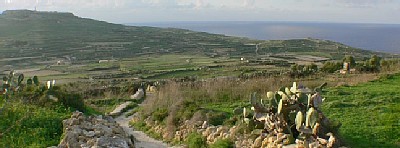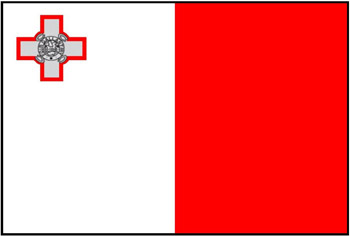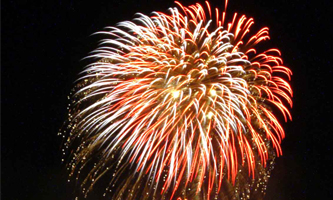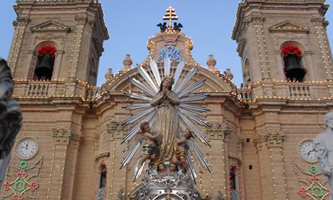
About Gozo
Malta's sister island, has long been one of Europe's most popular holiday destinations, offering that entire long or short break requires. Village festivals, music, opera, recitals and concerts throughout the year demonstrate the islanders' love of celebration and culture. Blessed with glorious sunshine all year round, full of historic sites, wonderful buildings, richly decorated churches, restaurant and bars a plenty together with warm and friendly people make it a very special place. The rural, agriculture, easy way of life gives you a renewed appetite; forgotten flavours are here in full - for the time between harvesting the sun-warmed crops and enjoying them is less than 24 hours. You won't find food fresher than that!
The Citadel, in Victoria, Gozo's principal town, dominates the entire island. The sheer walls and massive masonry enclose a small town complete in itself. The absence of traffic, sense of history, and calm atmosphere held within the ramparts is a welcome refuge from the bustle of 'It Tok', the main square, where the surrounding shops offer silverware, lace, knitwear, glass and pottery, locally produced wine, fresh local bread, olives, cheeses, sun-dried tomatoes and all Gozo's fruit and vegetables, fresh from the surrounding farms.
The deep valley, walks among wild flowers, cliff tops, sandy beaches, small villages, wonderful views and boat trips around the spectacular rugged coasts are all here. Don't miss a visit to the Blue Lagoon at Comino, a magical island with perfect swimming in crystal clear waters. So much within easy reach for a holiday worth remembering and even more worth repeating, time and time again.
At any time of the year, Gozo, with its endless hours is a delight. It is an island full of smiles and welcome, a concentrated jewel of rest and pleasure, where the past values of trust and kindness, customs fixed in the ways of old are treasures which the Gozitan's defend and preserve with great pride.
It is yours to discover, yours to enjoy.
Island of Myth & Miracles
The cave was sheltered by a copse of alders and fragrant cypresses, which was the roosting place of wide-winged birds, horned owls and falcons and cormorants with long tongues, birds of the coast, whose business takes them own to the sea. Trailing around the mouth of the cavern was a thriving garden vine, with great bunches of grapes; from four separate neighbouring springs four crystal
rivulets were channelled to run his way and that; and in soft meadows on both side iris and wild celery flourished. It was indeed a spot where even an immortal visitor must pause to gaze in wonder and delight.
The Odyssey, V. 63-74, Bk. 5 Homer
Gozo, Its Geography
Roughly circular in shape 14km by 7km in area, Gozo is hilly in the south-west to the north-west, the coast being almost entirely cliffs. The hills of Gozo are curiously rounded and flat-topped, the result of hard rock lying on soft rock (clay). The highest point is the Ta' Dbiegi Hill rising 190 metres above sea level. Another peak of the island is the Ta' Cenc that juts out like a bastion in the sea. Several narrow valleys cut through and dissect the plateau - the best known being Marsalforn, Xlendi and Ramla Bay.
Gozo is the second largest island of the Maltese archipelago that consists of three islands known as Gozo, Comino and the main island Malta. Millions of years ago the Maltese islands were elevated regions on a mass of land southwards Sicily. This continental shelf was submerged when the sea level rose during the interglacial leaving those land tips exposed in the centre of the Mediterrenean Sea.
Culture of Gozo
Gozo is rural and simple, its culture and way of life rooted in fishing and in primitive pastoral and agricultural activity. Tomatoes, potatoes, onions, melons, grapes, figs, oranges and tangerines are the island's prime agricultaral produce.
The island's hamlets and villages, which are perfectly still, with their strong wooden doors closed and their windows shuttered, appear to be deserted at certain times of the day. A boy in shorts might free-wheel and old bicycle down the centre of a street, or a girl in a faded cotton dress might run to her grandmother's house with a reed basket containing a fresh loaf and some tomatoes. A dog might also twitch its tail, lying stupefied by the heat and silence right in the middle of the road. There is no fear of walking around at night. The sense of safety and security is tangible. In fact many villagers leave their keys in their front doors - custom which occasionally can be seen.
Gozo is tranquil, and treasures its peace. For some, the silence can be overwhelming, but not for those for whom it spells a blessed respite from the trials and tribulations of everyday life. Gozo is not for those who like wild clubbing, but for those who treasure their peace of body and soul and a slow rhythm of life, although a couple of excellent night spots are a hive of activity among locals during the
summer months.
Village bars open early in the morning to cater for early risers who attend the first mass of the day. These watering-holes, with wooden chairs, marble counters and large metal trays containing the local delicacy; pastizzi, are a cultural icon.
History of Gozo
The Temple Period (4100 - 2500 B.C.)
The Greatest undertaking of pre-phoenician Gozitans are undoubtely Ggantija Temples situated in Xaghra and documented as the oldest free standing structure in the world. The temple consists of two temples, contained withing a single outer wall. Although sharing a common facade each has a separate entrance.
The Bronze Period (2500-700 B.C.)
Unlike their predecessors, these people were warlike people who used copper and bronze tools and weapons and who cremated their dead instead of burying them. Among the interesting remains, there are three dolmens on the Ta' Cenc plateau. These consist of horizontal, roughly shaped slab of limestone supported by three sides by blocks of stone.
Romans (218 B.C. - 535 A.D.)
At around 218 B.C. the Carthaginians were ousted by the Romans. In Gozo they created a municipuim, autonomous of that of Malta. Under the Romans, in A.D. 60, Saint Paul the Apostle, while journeying to Rome, was shipwrecked in Malta. Many remains of this time are to be found in museums all over the islands.
The Arabs (870 - 1127)
In 870 the aglabid Arabs became sole masters of the Maltese archipelago. The Punic dialect that had originated with the phoenicians was then greatly affected in its structure. The Arabs' stay is evidence by the place-names and family names especially by the name they gave to the island of Gozo -'Ghawdex' that still survives to this day.
European Domination (1127 - 1530)
Count Roger the Norman, freed the islands from the Arabs, who however remained masters paying a tribute. In 1127, the Norman's took formal possesion. Under these rulers, the island was governed by a series of feudal lords that wrecked all the possibilieties of a free island due to heavy taxation.
The Knights of St. John (1530-1798)
The Order of St. John of Jerusalem arrived in Malta in 1530. In 1524 Charles V offered the Order the Maltese Islands together with the fortress at Tripoli. The Order did not accept the offer immediately due to the fact that the islands were military undeveloped. At the end circumstances forced the order to choose the Maltese islands as their only military base. The order left their "foot print" on their islands and one can still admire the Valletta fortifications and many castles and other fortifications around the islands. It is also worth mentioning the great siege of Malta in 1565, where the Maltese population together with the order defeated the Turkish invaders on 8th September.
The French (1798 - 1800)
On 10th June 1798, the French under General Napoleon Banaparte, ousted the Knights from Malta. Their role in Gozo was short-lived. In September the people rose against the French, who, on 28 October surrended to the Gozitans. Gozo enjoyed a short period of autonomy till 5 Semptember 1800, when the British took the Maltese Islands under their protection.
British (1800 - 1964)
Malta and Gozo became formally British in 1813 and the island was transformed in a fortress colony. Its resistance and hardship to the Nazisistic bombardments in the Second World War are legendry - in fact the poeple were awarded the George Cross that lies happily on the flag. Malta was declared Republic on 13 December 1974 following the gaining of independance that was due on 21 September 1964.
Villiage Festas
The curse of fear and terror under which the Gozitans lived for so long, coupled with the insecurity of a livelihood fully dependent on the elements and limitations of a small island, has made them sticklers for devotion to their favourite saints. Saints were the last hope in the darkness, and religious images served as protective devices against the cruel vagaries of a harsh existence. Religious culture in Gozo remains strong, with God taking second place to His saints. Devotional fervour erupts in great feasts which take place in the summer months. These village festas are unparalleled on the continent so the English words feast, festival or holy day, do not convey a true meaning of these celebrations.Every weekend from the last Sunday in May up to mid-September, each town and village organises a festa in honour of the patron saint to whom the parish is dedicated. In these festas, the spiritual and the secular intermingle, religion and folklore abound. These celebrations have long been an important event and the rivalry between the villages reaches sky high proportions. A festa worthy of the name is made up of illuminations, brass bands, fireworks and a procession. The facade of the village church as well as the principal streets are decorated with thousands of twinkling lights. From the Wednesday preceding the festa to its eve, several brass bands march through different streets preceded and followed by the young and not so young who revel in dancing and merrymaking. The beginning and end of these marches are marked by a profusion of multi-colored ground and aerial fireworks. On Sunday afternoon, in the town and larger villages, there is also a traditional horse and donkey race along the main street. The climax of the festa is reached on Sunday.
Bays and Beaches
There are beaches of red sand, like Ramla l-Hamra, literally 'red sands' Ramla l-Hamra, literally 'red sands' where turtles once bred is nowadays a truly magnificient beach, golden coast and calm waters., and San Blas, white sands like Dahlet Qorrot, magnificient deep-water inlets that wind their way through the cliffs, like Xliendi and Mgarr ix-Xini, or coves of pebbles, like the romantically called Hondoq ir-Rummien (Pomegrante Cove). Xliendi is where Phoenician galleys sought shelter and where on a treacherous reef, they were wreaked, leaving amphore lying in stillnes in the dept of azure windows.





� Copyright 2011 - Victory Garage
For your holiday in any of our converted farmhouses, holiday apartments or other accommodation on the island, we offer direct transfers from the Malta International Airport to the island of Gozo. From then on, travelling on this unique island is no problem. Our chauffeur driven Mercedes cars, mini-buses or mini-coaches...
We offer friendly chauffeur driven services for small or large groups and individuals, twenty-four hours a day, seven-days a week all year round with our luxorious and air-conditioned Mercedes cars and mini-buses, Ford Transits mini-buses and mini-coaches. Thanks to our professionally trained licensed drivers our services are second to none...
Malta's sister island, has long been one of Europe's most popular holiday destinations, offering that entire long or short break requires. Village festivals, music, opera, recitals and concerts throughout the year demonstrate the islanders' love of celebration and culture. Blessed with glorious sunshine all year round...
Transfers & Tours
Our Fleet
About Gozo
About Us
Transfers & Tours
Our Fleet
About Gozo


Friendly Service
Meeting Customers'
Expectations & Demands
Chauffeur Services
Holiday Accomodation
Tourist Service
Tourist Service

























